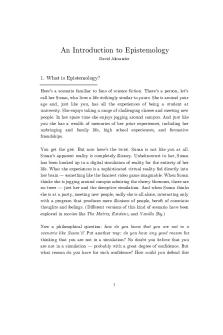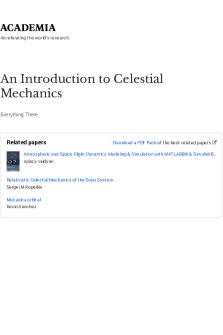Summary An Introduction to Classroom Observation PDF

| Title | Summary An Introduction to Classroom Observation |
|---|---|
| Course | Teaching English as a Foreign Language |
| Institution | University of Birmingham |
| Pages | 3 |
| File Size | 74.3 KB |
| File Type | |
| Total Downloads | 115 |
| Total Views | 146 |
Summary
Wragg, e.c. 1997. An Introduction to Classroom Observation. London: Routledge...
Description
CLASSROOM OBSERVATION
Wragg, e.c. 1997. An Introduction to Classroom Observation. London: Routledge
A. An Introduction to classroom observation Jackson (1968) primary teachers involved in 1,000 interpersonal exchanges every day. Adams and Biddle (1970) a change in activity happens every 5 to 18 seconds, average each lesson of 174 changes in who talked and who listened. Classroom observation is now becoming far more common than it once was. The advent of systematic teacher appraisal and lesson evaluation, the greater emphasis on developing the professional skills of initial trainees, or horning those of experienced practitioners, the increased interest in classroom processes by curriculum developers, all of these have led to more scrutiny of what actually goes on during teaching and learning. If lessons are worth observing then they are also worth analysing properly, for little purpose is served if, after a lesson, observers simply exude goodwill, mumble vaguely, or appear to be uncertain why they are there, or what they should talk about. Skilfully handled, classroom observation can benefit both the observer and the person observed, serving to inform and enhance the professional skill of both people. Badly handled, however, it becomes counter-productive, as its worst arousing hostility, resistance and suspicion. The purpose, timing and context of an observation should largely determine its methods, and this book describes how a range of an approaches can be employed to meet a variety of needs. The elements of the classroom The ecology of classrooms can be extremely rich and full, the main constituent of them are teachers, pupils, buildings and materials. Teachers own background, personality, interests, knowledge, intentions and preferences will influence much of what occurs, such as the strategies they employ in different situations, the timing and nature of their questions and explanations, their responses to misbehaviour, indeed what they perceive to be deviant behaviour. As classroom life can be busy and rapidly changing, some teachers may play the following roles: Traditional one of transmitter of knowledge Counsellor (advising pupil about careers, aspirations or problems) Social worker (dealing with family issues) Assessor (marking children’s work, giving test, writing reports) Manager (looking after resources, organising groups, setting goal) Jailer (keeping in school reluctant attenders or checking up on possible truants) While some students may play the following roles: Learners of knowledge, skills, attitudes or behaviour
Deviants (misbehaving, not doing what the teacher has asked) Jokers (laughing, creating humour which was lighten or heighten tension) Collaborators (working closely with others as members of a team or group) Investigators (enquiring, problem solving, exploring, testing hypotheses) Servants (moving furniture, carrying and setting up equipment
Students will often be conscious of other members of their peer group, especially in adolescence, and this too will sometimes form a powerful influence on what they do.
Withall (1949) 7 category system consisting of -
three learner centred (Reassuring, Accepting, questioning) three teacher centred (directing, reproving, justifying own actions) neutral (e.g. administration)
Recording the observation Method written account
Video cassette
Sound cassette
Transcript
Advantages Immediate and fresh account available; economic use of time; account can be available for discussion immediately after lesson; full picture of events available to observer at time of observation.
Disadvantages Observer must make immediate decisions about what to record, so may be superficial or unreliable account, no chance of action replay; some effects on class behaviour because of observer’s presence Good visual and sound record Loss of information such as which can be replayed several room temperature, smells, times; no pressure to make events out of camera shot, instant decisions; focus can on effects on class of presence of teacher only or on individual camera; increase in time or group of pupils; lesson can needed for analysis. be discussed with participants. Good sound record can be Loss of important visual cues replayed several times for such as facial expressions, discussion, analysis, or gesture, body language, corroboration of written movement, sound quality can account; radio microphone can be poor; difficult to identify be used to obtain high quality individual children who speak, record of what the teacher analysis time substantially says; observer’s comments can increased. be recorded simultaneously on twin-track tape; allows lesson to be transcribed by audio typist. Enables really detailed analysis Loss of important visual and at leisure; permits analysis by sound cues such as tone of several people not necessarily voice, volume of noise, in the same place, as text can emphasis; high cost in time
be distributed easily; person being observed can work on specific aspects of language, such as choosing good examples or analogies, using an appropriate vocabulary.
and money to have lessons transcribed (one lesson might fill 20 or 30 pages); difficulty of deciding what to focus on if numerous transcripts are collected....
Similar Free PDFs

First Classroom Observation
- 5 Pages

An introduction to Psychology
- 4 Pages

An introduction to sociolinguistics
- 451 Pages

1. An Introduction to Epistemology
- 10 Pages

1. An Introduction to Glaciers
- 6 Pages

How to write an Introduction
- 3 Pages

An Introduction to English Grammar
- 324 Pages

An Introduction to Celestial Mechanics
- 217 Pages

An Introduction to Linguistics ( PDF)
- 135 Pages

An Introduction to Well Integrity
- 154 Pages
Popular Institutions
- Tinajero National High School - Annex
- Politeknik Caltex Riau
- Yokohama City University
- SGT University
- University of Al-Qadisiyah
- Divine Word College of Vigan
- Techniek College Rotterdam
- Universidade de Santiago
- Universiti Teknologi MARA Cawangan Johor Kampus Pasir Gudang
- Poltekkes Kemenkes Yogyakarta
- Baguio City National High School
- Colegio san marcos
- preparatoria uno
- Centro de Bachillerato Tecnológico Industrial y de Servicios No. 107
- Dalian Maritime University
- Quang Trung Secondary School
- Colegio Tecnológico en Informática
- Corporación Regional de Educación Superior
- Grupo CEDVA
- Dar Al Uloom University
- Centro de Estudios Preuniversitarios de la Universidad Nacional de Ingeniería
- 上智大学
- Aakash International School, Nuna Majara
- San Felipe Neri Catholic School
- Kang Chiao International School - New Taipei City
- Misamis Occidental National High School
- Institución Educativa Escuela Normal Juan Ladrilleros
- Kolehiyo ng Pantukan
- Batanes State College
- Instituto Continental
- Sekolah Menengah Kejuruan Kesehatan Kaltara (Tarakan)
- Colegio de La Inmaculada Concepcion - Cebu





